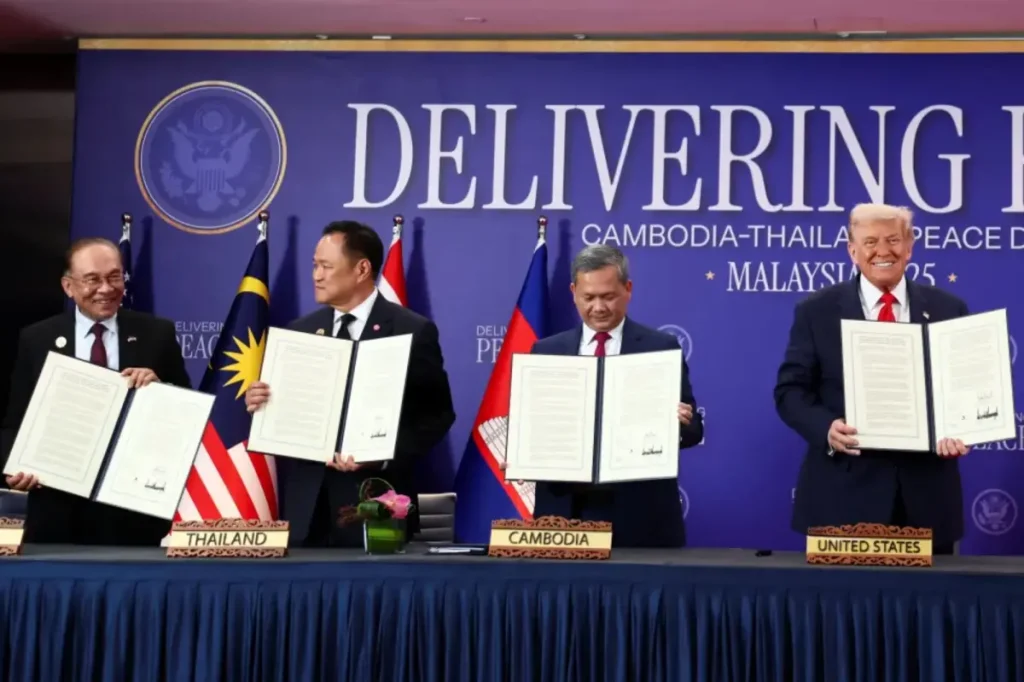Trump’s Diplomatic Triumph in Southeast Asia: Peace Deals and Economic Partnerships
President Trump made significant diplomatic strides during his visit to Kuala Lumpur, Malaysia, where he signed peace and trade agreements with Cambodia, Thailand, and Malaysia. At the ASEAN conference, Trump positioned himself as a peacemaker by formalizing a truce he had brokered in July between Cambodia and Thailand, potentially saving countless lives in the region. During the signing ceremony, Trump expressed frustration with the United Nations for its lack of involvement in resolving international conflicts, stating, “The United Nations should be doing this, but they don’t do it.” Despite his criticism, Trump appeared proud of his achievement, describing peacekeeping as “something that I’m good at, and it’s something I love to do.” He even indicated his readiness to tackle tensions between Pakistan and Taliban-ruled Afghanistan, confidently asserting he could resolve that conflict “very quickly.”
The atmosphere at the event was surprisingly lighthearted, with Malaysian Prime Minister Anwar Ibrahim joking about their shared experiences with legal troubles. “We share lots of things in common. I was in prison, but you almost got there,” Ibrahim quipped, referencing Trump’s legal challenges before winning the election. Cambodian Prime Minister Hun Manet expressed deep gratitude for Trump’s intervention in the border conflict, revealing he had nominated Trump for the Nobel Peace Prize for his role in stopping the violence that had claimed at least 66 lives. The peace deal specified military pullbacks from disputed border regions and prisoner exchanges, effectively ending the five days of fighting that had erupted in July. Trump’s approach combined diplomacy with economic leverage, as he had previously threatened higher tariffs against both export-oriented nations if they couldn’t reach a cease-fire.
The trade agreements signed at the summit represented significant economic opportunities for both the United States and the Southeast Asian nations. Under the new deals, Trump lowered his “reciprocal” tariffs for Cambodia, Thailand, and Malaysia from previously threatened high rates. For Cambodia, tariff rates on most clothing exports—vital to their economy—were reduced to between 7% and 15%. While specific details for Thai and Malaysian goods weren’t immediately released, the agreements indicated that certain products could eventually face tariff rates as low as zero percent. These favorable trade terms were tied to commitments from the Southeast Asian nations to purchase American goods and services, demonstrating Trump’s transactional approach to international relations, focusing on creating tangible economic benefits for the United States while providing incentives for peace and cooperation.
In exchange for the reduced tariffs, the Southeast Asian countries made substantial commitments to purchase American goods. Cambodia agreed to buy ten Boeing 737 MAX 8 planes for its national airline, bolstering the American aerospace industry. Thailand’s commitments were even more extensive, promising $2.6 billion in additional purchases of US agricultural products, including corn and soybeans, along with $5.4 billion in American energy products such as liquified natural gas. Additionally, Thailand agreed to purchase 80 US-made aircraft for $18.8 billion. Malaysia’s commitments were equally impressive, including plans to buy 30 planes, spend $150 billion on US technology hardware (including semiconductors), purchase $3.4 billion per year of liquified natural gas, and invest $70 billion in the United States. These agreements reflect Trump’s emphasis on reducing trade deficits and creating American jobs through international agreements.
Beyond trade and peace, the agreements also addressed strategic concerns about China’s influence in the global supply chain. New critical minerals agreements with Thailand and Malaysia outlined plans for future investments and established a “pricing framework including price floors or similar measures” designed to counter Chinese export controls. This approach aligns with a landmark agreement Trump signed with Australia the previous week, aimed at countering “non-market policies” from Beijing. These arrangements demonstrate Trump’s ongoing strategy to build economic alliances that can serve as counterweights to China’s growing economic power, particularly in critical sectors like rare earth minerals and semiconductor manufacturing. By securing these agreements, Trump is working to reduce American dependency on Chinese supply chains while strengthening ties with alternative partners in the Asia-Pacific region.
President Trump’s visit to Malaysia came after a diplomatic stop in Qatar, where he hosted discussions on implementing his 20-point peace plan in Gaza, which had ended two years of war on October 10. Upon arriving in Malaysia after a 23-hour flight from Washington, Trump unexpectedly participated in a dance with native performers on the tarmac, adding a cultural dimension to his diplomatic mission. The president’s whirlwind diplomatic tour showcased his willingness to engage directly in resolving international conflicts through a combination of personal diplomacy and economic incentives. By securing peace between Cambodia and Thailand while simultaneously negotiating favorable trade terms for American exports, Trump demonstrated his transactional approach to foreign policy—using America’s economic leverage to advance both peace and prosperity. The success of these agreements will ultimately depend on their implementation, but they represent significant diplomatic achievements that combine security, economic, and strategic objectives in a region of growing importance to American interests.


